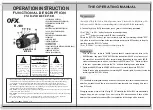
FCC ID: K6610443140
IC ID: 511B-10443140
Alignment
4/5
Vertex Standard Co., Ltd.
Alignment Channel Frequencies
Channel Frequency
(Simplex)
CTCSS
Encode
DCS
Encode
Narrow
/wide
CH1 134.00MHz None None Wide
CH2 140.50MHz None None Wide
CH3 147.00MHz None None Wide
CH4 153.50MHz None None Wide
CH5 160.00MHz None None Wide
CH6 134.00MHz None None Narrow
CH7 140.50MHz None None Narrow
CH8 147.00MHz None None Narrow
CH9 153.50MHz None None Narrow
CH10 160.00MHz None None Narrow
CH11 147.00MHz
151.4Hz None Wide
CH12 147.00MHz None 023 Wide
CH13 147.00MHz
151.4Hz None Narrow
CH14 147.00MHz None 023 Narrow
PLL & Transmitter
Set up the test equipment as shown for transmitter
alignment.
Maintain the supply voltage at 13.8 V DC for all steps.
PLL VCV
Connect the positive lead of the DC voltmeter to the test point TP1001 (VCV) on the Main Unit, as
indicated in the figure, and the negative lead to chassis ground.
Key the transmitter, and adjust coil L1020 on the Unit for 1.5 V on the voltmeter.
Next select to the band center (low edge) frequency channel (CH2) and confirm about 6.8 V (6.5V –
7.2V) on the voltmeter.
Next select to the high band frequency channel (CH4) and confirm about 6.8 V (6.5V – 7.2V) on the
voltmeter.
Key the transmitter, and confirm about 6.8 V (6.5 V – 7.2 V) on the voltmeter.
Transmitter Output Power
Select band center frequency channel, and select high power output level.
Key the transmitter and adjust by control commands for high power from the computer for 50 ± 1 W as
indicated on the wattmeter.
Select band center frequency channel, and select low power output level.
Key the transmitter and adjust by control commands for low power from the computer for 10 ± 0.1 W
as indicated on the wattmeter.























